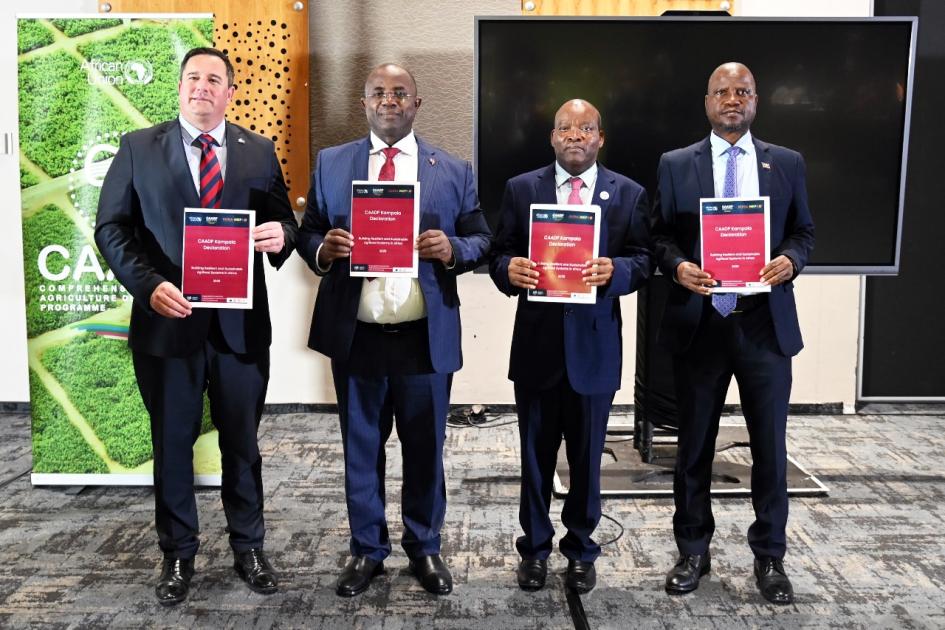The African Union has launched the Kampala CAADP Strategy and Action Plan (2026 – 2035), which aims to mobilize $100 billion, lift agrifood output by 45$, triple intra-African trade in farm goods, and cut post-harvest losses into half.
The Comprehensive African Agricultural Development Programme (CAADP) is an Agenda 2063 continental initiative, aimed at helping African countries eliminate hunger and reduce poverty by raising economic growth through agriculture-led development. The Launch that took place during the two-day conference in Johannesburg, South Africa, has now raised the stakes for food systems, with the Kampala CAADP Declaration now signed.
Delivering the keynote address, Fred Kyakulaga Bwino, Minister of State for Agriculture, from Uganda/Chair of the African Union Specialized Technical Committee (STC) on Agriculture, Rural Development, Water and Environment (ARDWE) said, this is the third in a series of CAADP strategies, the first having been espoused in the Maputo Declaration in 2003, the second in the Malabo Declaration in 2014, and now the CAADP Kampala Declaration 2025.
Bwino noted that the responsibility for leading the implementation process lies squarely with governments and asked continental institutions to play the broader coordination and monitoring role, involving more critical stakeholders at all stages.
“There are key CAADP aspects such as market opening, infrastructure development or pest and disease control that are better managed through inter-country collaboration, hence the need for Regional Economic Communities (RECs) to play the lead role ” Bwino said.
On his part, the African Union Commissioner for Agriculture, Rural Development, Blue Economy and Sustainable Environment (ARBE), Moses Vilakati, said that the new CAADP Strategy and Action Plan 2025-2036 marks a significant shift towards agrifood systems transformation.
“We recognize that agriculture is not just about production, but about creating a holistic system that encompasses production, processing, distribution, and consumption. It also envisions sustainable and resilient agri-food systems for a healthy and prosperous Africa,” he said.
“Through this strategic document, the continent has been offered a springboard to create greater coherence in the bid to drive nature-positive agricultural production systems that will support ecosystem restoration and bio-diversity gain,” Commissioner Vilakati emphasized.
Currently, Africa is home to nine of the 10 countries most vulnerable to climate change, and African Union Member states are already diverting up to 9 per cent of their national budgets to respond to climate extremes.
South Africa’s Minister of Agriculture, John Steenhuisen, challenged leaders on the continent to invest and uphold commitments made to a continentwide plan that will see the continent feed itself in a decade.
Steenhuisen said the continent must eliminate distortions and resolve market failures hindering technology adoption as part of efforts to enhance agricultural growth and productivity while increasing the level and efficiency of farm investments for a broader impact.
“The agrifood system requires innovative technologies to adapt suitably to local social conditions and be updated in response to environmental factors, such as the co-evolution of pests and diseases, degradation of water and land resources, and climate change,” Steenhuisen said.
Addressing the launching event virtually, Nardos Bekele, CEO of AUDA NEPAD said the launch of the strategy and the Kampala declaration will accelerate the full implementation of the AfCFTA to boost intra-African trade, sustain the Programme for Infrastructure Development in Africa (PIDA) and its catalytic investments, and fast-track the post-Malabo CAADP Biennial Reviews (BR) that sharpen our policy compass.
Delegates also heard that delivering on the CAADP Kampala Agenda in the next decade will require re-evaluating agricultural and nutrition policies that embrace the growing complexities of urbanization, population growth, the challenges posed by youth, and shifting points of influence in planning

